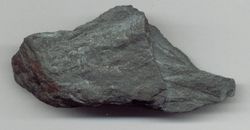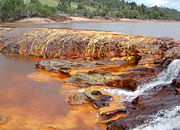Iron Ore

 |
| Hematite: the main iron ore in Brazilian mines. |
 |
| The red appearance of this water is due to iron in the rocks. |
|
| |
Iron ores are rocks and minerals from which metallic iron can be economically extracted.
The ores are usually rich in iron oxides and vary in colour from dark grey, bright yellow,
deep purple, to rusty red. The iron ore is usually found in the form of magnetite (Fe3O4),
hematite (Fe2O3), goethite, limonite or siderite. Hematite is also known as "natural ore". The
name refers to the early years of mining, when certain hematite ores contained 66% iron and could
be fed directly into iron making blast furnaces. Iron ore is the raw material used to make pig iron,
which is one of the main raw materials to make steel. 98% of the mined iron ore is used to make steel.
Sources
Pure
iron is virtually unknown on the surface of the Earth except as Fe-Ni alloys from meteorites
and very rare forms of deep mantle xenoliths. Therefore, all sources of iron used by human
industry exploit iron oxide minerals, the primary form which is used in industry being hematite.
However, in some situations, more inferior iron ore sources have been used by industrialized
societies when access to high-grade hematite ore was not available. This has included utilisation
of taconite in the United States, particularly during World War II, and goethite or bog ore used
during the American Revolution and the Napoleonic wars. Magnetite is often used because it is
magnetic and hence easily liberated from the gangue minerals.
Inferior sources of iron ore generally require beneficiation. Due to the high density of hematite
relative to silicates, beneficiation usually involves a combination of crushing and milling as
well as heavy liquid separation. This is achieved by passing the finely crushed ore over a bath
of solution containing bentonite or other agent which increases the density of the solution.
When the density of the solution is properly calibrated, the hematite will sink and the silicate
mineral fragments will float and can be removed.
Iron ore mining methods vary by the type of ore being mined. There are four main types of iron
ore deposits worked currently, depending on the mineralogy and geology of the ore deposits.
These are magnetite, titanomagnetite, massive hematite and pisolitic ironstone deposits.
Magnetite banded iron deposits
Banded iron formations (BIF) are fine grained metamorphosed sedimentary rocks composed predominantly
of magnetite and silica (as quartz). Banded Iron formations are locally known as taconite within North America.
Mining of BIF formations involves coarse crushing and screening, followed by rough crushing and
fine grinding to comminute the ore to the point where the crystallised magnetite and quartz are
fine enough that the quartz is left behind when the resultant powder is passed under a magnetic separator.
The mining involves moving tremendous amounts of ore and waste. The waste comes in two forms,
bedrock in the mine that isn't ore (mullock), and unwanted minerals which are an intrinsic part
of the ore rock itself (gangue). The mullock is mined and piled in waste dumps, and the gangue
is separated during the beneficiation process and is removed as tailings. Taconite tailings are
mostly the mineral quartz, which is chemically inert. This material is stored in large,
regulated water settling ponds.
The typical grade of iron at which a magnetite-bearing banded iron formation becomes economic
is roughly 25% Fe, which can generally yield a 33% to 40% recovery of magnetite by weight,
to produce a concentrate grading in excess of 64% Fe by weight. The typical magnetite iron
ore concentrate has less than 0.1% phosphorus, 3-7% silica and less than 3% aluminium.
Magmatic magnetite ore deposits
Occasionally granite and ultrapotassic igneous rocks segregate magnetite crystals and
form masses of magnetite suitable for economic concentration. A few iron ore deposits,
notably in Chile, are formed from volcanic flows containing significant accumulations of
magnetite phenocrysts. Chilean magnetite iron ore deposits within the Atacama Desert have
also formed alluvial accumulations of magnetite in streams leading from these volcanic formations.
Some magnetite skarn and hydrothermal deposits have been worked in the past as high-grade
iron ore deposits requiring little beneficiation. There are several granite-associated
deposits of this nature in Malaysia and Indonesia.
Hematite ore
Hematite iron ore deposits are currently exploited on all continents, with the largest
intensity of exploitation in South America, Australia and Asia. Most large hematite iron
ore deposits are sourced from metasomatically altered banded iron formations and rarely
igneous accumulations.
Hematite iron is typically rarer than magnetite bearing BIF or other rocks which form its
main source or protolith rock, but it is considerably cheaper and easier to beneficiate the
hematite ores and requires considerably less energy to crush and grind. Hematite ores however
can contain significantly higher concentrations of penalty elements, typically being
higher in phosphorus, water content and
aluminium.
In Australia iron ore is won from three main sources: pisolite "channel iron deposit"
ore derived by mechanical erosion of primary banded-iron formations and accumulated
in alluvial channels such as at Pannawonica, Western Australia; and the dominant
metasomatically-altered banded iron formation related ores such as at Newman, the
Chichester Range, the Hamersley Range and Koolyanobbing, Western Australia. Other
types of ore are coming to the fore recently, such as oxidised ferruginous hardcaps,
for instance laterite iron ore deposits near Lake Argyle in Western Australia.
The total recoverable reserves of iron ore in India are about 9,602 million tones of
hematite and 3,408 million tones of magnetite. Madhya Pradesh, Karnataka, Bihar, Orissa,
Goa, Maharashtra, Andhra Pradesh, Kerala, Rajasthan and Tamil Nadu are the principal
Indian producers of iron ore.
Production and consumption
Iron is the world's most commonly used metal. It is used primarily in structural engineering
applications and in maritime purposes, automobiles, and general industrial applications (machinery).
Iron-rich rocks are common worldwide. The major constraint to economics for iron ore
deposits is not necessarily the grade or size of the deposits, because it is not particularly
hard to geologically prove enough tonnage of the rocks exist. The main constraint is the
position of the iron ore relative to market, the cost of rail infrastructure to get it to
market and the energy cost required to do so.
World production averages one billion metric tons of raw ore annually. The world's
largest producer of iron ore is the Brazilian mining corporation CVRD, followed by Australian
company BHP Billiton and the Anglo-Australian Rio Tinto Group. A further Australian
supplier, Fortescue Metals Group Ltd, is currently entering the development stage and may
eventually bring Australia's production to second in the world.
World consumption of iron ore grows 10% per annum on average with the main consumers being
China, Japan, Korea, the United States and the European Union.
China is currently the largest consumer of iron ore, which translates to be the world's
largest steel producing country. China is followed by Japan and Korea, which consume a
significant amount of raw iron ore and metallurgical coal. In 2006, China produced
588 million tons of iron ore, with an annual growth of 38%.
